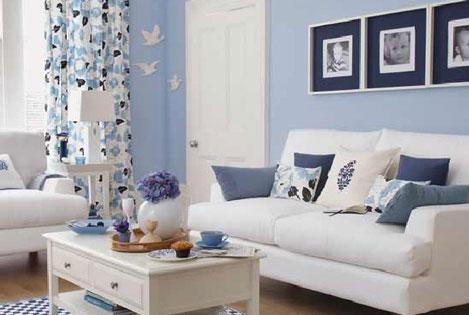"A small room is relative," says interior designer Ines Wrusch. "A room is only too small when you plan to use it for something big." Because in most cases it's impossible to alter a room's dimensions you will need to fall back on a few tricks to get the desired look.
"The most effective thing you can do is exploit optical illusions," says home design expert Katharina Semling. Well-chosen decorations, appropriate furnishings and clever lighting can help.
But the most important factor to pay attention to is colour.
"Small rooms look bigger if they're painted in bright colours," says Professor Harald Braem from the Institute of Colour Psychology in Germany.
"Just as you can make a high ceiling appear lower by painting it a dark shade, you can also achieve the opposite effect with a lighter tone." White and pastel shades tend to make a room look larger than it is.
Semling recommends painting doors, window frames and bevelled edges a pure white colour. If you're planning on using a colourful wallpaper try painting a narrow white line on the walls directly below the ceiling. If you have chosen a primary colour then you can expect that to make a big difference to the way the room will appear.
"A dominant red colour will make itself felt very present in a room," says Braem. "It's a hectic colour and tends to push aside other colours in a room." Red should be used sparingly in small spaces.
In many instances the reason a room appears small is due to its design. Ines Wrusch illustrates the problem using an example of a bathroom that has been built in an old apartment: such bathrooms tend to be narrow and thus have disproportionately high walls compared to the ground space they occupy.
"The dimensions are wrong. But as soon as the ceiling is lowered with the aid of a dry wall board, for example, then it appears to be the right size."
Once again colour can also be of help. "By painting a dark blue colour on the walls above a height of 2.40 metres you will achieve the same effect." That's because dark colours make a "heavy" impression and give the optical illusion of the room expanding.
Another aspect to consider is furnishings. "Under no circumstances should a small room be packed full of decorations and knick-knacks," says Semling. "But a very spartan interior is also the wrong way to go."
A collection of decorations on the opposite wall to the doorway is sufficient. Big tiles in a bathroom will achieve a bigger look but large-scale, baroque-style wallpaper patterns will shrink a room.
Curtains made of lightweight materials will also make things roomier.
"They don't steal light and they can embellish a space," says Semling.
Large furniture and objects that go over the eyeline should be avoided. "Make every effort to concentrate on the lower regions of a room," says Semling. "But if you have to use a tall cupboard then it should be as brightly coloured at the top as possible."
Glass tables are also counter productive. "At first glance they appear to give a light look but because they're transparent you can see the legs and everything that's beneath the table." That only serves to disturb the optical harmony of a room.
And finally lighting can help determine a room's apparent size.
Semling advises creating islands of light. "That will allow you to customise a room's structure into separate areas."
Ines Wrusch recommends using what are known as wall washer lighting systems that consist of LED lamps that can flood a wall with light. "No matter if you use it to illuminate a single wall or the entire ceiling, it will make a room seem bigger."
So, light and colour are the keys to altering a room's appearance.
Bareness is the worst way to achieve a bigger look. "A small empty space usually looks even smaller than one that is furnished and has wallpaper," Semling says.



















__small.png)










